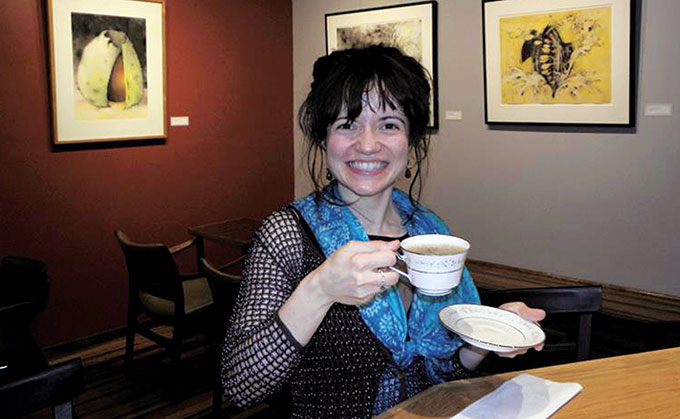Classical Mode: Cool
by Jan Jezioro

The resAUnance trio creates a new sound that invites the listener in
What can you expect when a talented trio of performers, equally at home in jazz originals and jazz improvisations, as well as contemporary avant-garde classical music, and who all happen to be accomplished composers get together? Judging from the first performances of the resAUnance trio—vocalist Esin Gündüz, keyboard player Michael McNeil and the legendary local percussionist John Bacon—you can expect to hear a distinctive sound, centered on the ethereal, wordless singing of Gündüz, which will take you to places you haven’t experienced before. The group will appear this Friday at 8pm at the PAUSA Art House, 19 Wadsworth Street at the foot of Allen, the hippest new place to hear music in the city.
Michael McNeil, a graduate of the Longy School of Music in Cambridge, and one of the busiest freelance musicians in Buffalo, explains how the group got together: “It’s kind of funny how it happened. John Bacon had wanted to add Esin Gündüz to our jazz quartet [with trumpeter Tim Clarke and bassist Dave Arenius], so John, Esin, and I got together to introduce Esin to our music. The room where we rehearsed didn’t have a proper drum set, so John played vibraphone. In the middle of one of the tunes, I thought, ‘Hey, this could be a band right here,’ and a then a few minutes later, John said, ‘This could be a band right here.’ Esin mentioned how inspired and comfortable she felt singing with the resonance of those two instruments, vibraphone and piano, on each side of her. So we went ahead and did some quintet gigs with Esin, but kept the idea in mind. When Jon Nelson, asked me what group I’d like to bring to his PAUSA Art House, I immediately thought of this trio”.
“This music is colorful certainly, because of our unique instrumentation,” says Gündüz, a graduate of Istanbul Bilgi University and a PhD candidate in music composition at UB, “and it has improvisational qualities but it is not restricted to any style, or geographical roots. We’ll be playing a couple pieces out of Stockhausen’s Tierkreis on Friday, and I’m considering bringing in a lied from Schoenberg’s Erwartung, for our next concert in July. Music is made of physical vibrations, and there is a duality to the quality of those two instruments. They can be percussive, and they can sustain sounds, and with voice, both of those qualities are possible. Sensorily, while the percussiveness creates some type of awareness of the present ‘moment’, the sustained sounds evoke sensory feelings of vastness, openness, and flow that can be said to stay at our timbral center. When we listen to our recordings, we realize that we depend on those qualities. Any music we play, let it be graphic scores, folk songs, jazz originals or improvisations, has some uniformity of sound, naturally, but the only limit to the style of music we play would be that of our imagination. This brings a wonderful freedom, both to the souls of the players, and to the audience.”
“If a listener is trying to find something in our music to latch onto,” says McNeil, “I’d recommend listening for the vertical blend of our instruments’ sounds, and for the ways in which each player’s musical lines interact with the others’ and then proceeds in their own direction. So far, John and I have brought some of our original music to the band, composed jazz originals or graphic scores for improvisation, and Esin has brought some Turkish folk songs and is planning to write some music for the group in the near future. Fortunately, the decision process for repertoire has been easy so far. Somebody brings in music, the others say, ‘This looks great—let’s do it.’”
Buffalo Chamber Players Season Finale
There are only a handful of works in the entire classical musical repertoire that can truly be classified as sublime, if we follow the thoughts of the first century AD Roman author Longinus. His influential treatise “On the Sublime” was only re-discovered in the 16th century, but it has had an inordinately powerful influence on Western philosophical theory regarding the arts.
On Wednesday, May 29 at 7:30pm, the Buffalo Chamber Players will conclude their innovative and successful season at the Buffalo Seminary on Bidwell Avenue, with a performance of Franz Schubert’s final chamber music work, the String Quintet in C major D. 956, a work generally regarded as sublime, due to its elevated, lofty thought and musical language. Also on the program is American composer John Harbison’s exquisitely heartfelt November 19, 1828, a tombeau, or tribute, to Schubert, composed for string trio and piano, celebrating the apotheosis of Schubert into the pantheon of musical greats on the day of his death.
Tickets are $15, $5 for students. For more information, visit www.buffalochamberplayers.org.
blog comments powered by Disqus|
Issue Navigation> Issue Index > v12n21 (Week of Thursday, May 23) > Classical Mode: Cool This Week's Issue • Artvoice Daily • Artvoice TV • Events Calendar • Classifieds |









 Current Issue
Current Issue